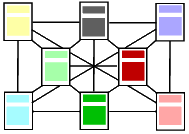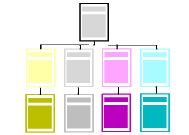| How pages can link to each other |
| There are three ways in which documents can link to each other on a web site. The most complex web sites use a combination of these three, but it is important to make these links simple and clear to follow.
Sequence structure A sequence structure brings us back to the example of the linear narrative that we referred to in planning your content outline. This would be used if the information being presented is linear in nature - for example if it is related to a time line (such as the growth of a frog or historical events), or the alphabet, or a logical order of events (a step-by-step explanation). A linear sequence is typically used for simple, smaller, structured sets of information such as these. Notice how, in the Trigonometry site, use is made of 5 pages in a linear structure in the understanding section, which relies on a logical explanation.
Web structure A web structure is characterized by the fact that each page provides access to all other pages. Notice in the diagram above how the lines join all documents with each other. This is most suitable for very small sites with limited information. Each sub-topic usually consists of only one page. You will see that this method of linking documents has been used in the African Astronomy site. This is not a simple topic, but the authors have provided a simple set of information. The problem with this method of structuring sites is that, once the site grows more complex, navigation becomes progressively less organized. The Micklefield school site started off with a web structure, but the excellent work that the learners and educators have done resulted in some sections growing beyond the web structure. In fact, in the Drama section, they have used a linear structure to tell you about their play called African Jigsaw.
Hierarchy structure A hierarchy structure is the most clearly organized and relates most closely to what readers experience from printed documents. The hierarchy structure forces you to organize your information very carefully, which is important for potentially complex topics. You want to make it as easy as possible for your readers to find the information they are most interested in. It is still possible to link any one page to any other pages, but this is only done when the link is appropriate. Many good web sites use this structure. As the web site grows, its structure becomes more complex, but the basic principle of operating from sub-menus from the home page still applies. The way in which you have laid out your content outline and site map in this module will promote the use of a hierarchy structure for the basis of linking files. |

